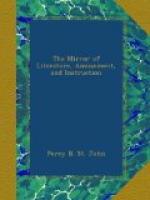distinctly visible. Beginning with the Castle,
we find, from its situation commanding the passes
and fords between the north and south of Scotland,
it was in early times styled the Key, as Dumbarton
was the Lock, to the Highlands. Its first fortification
is referred to the time of Agricola; the Picts had
a strong fortress here, which was totally destroyed
in the ninth century by the Scots, under Kenneth II.
Stirling formed part of the ransom of his brother
and successor, who had been taken prisoner by the
Northumbrians; they rebuilt the Castle, but subsequently
restored the place to the Scots. In the twelfth
century, it was considered one of the strongest forts
in Scotland. It was often visited by the Scottish
monarchs, but it did not become a royal residence until
the accession of the Stuarts. Here was born James
II., and in an apartment now forming part of the deputy-governor’s
lodging, this king perpetrated the murder of Earl
Douglas. James III. made it his chief residence,
erected the parliament-house, and a richly-endowed
chapel, since destroyed. James V. was crowned
here, and erected the palace. Mary was crowned
here, as was James VI. when thirteenth months old;
he was educated here by the celebrated Buchanan.
During the regency of Mary of Lorraine, a strong battery
was erected here; and in the reign of Queen Anne, the
fortifications were strengthened and enlarged.
In 1806, the rocky ground in front was converted into
an esplanade; since which the towers have been repaired
and castellated, it being one of the Scottish forts,
which, by the articles of the Union, are always to
be kept in repair. It mounts about 36 guns; but
if regularly invested in modern warfare, it could
not hold out many hours. To enumerate its sieges,
dismantlings, and repairs would occupy too much space.
Among the most memorable of its stormy annals, is
its siege by Edward II. in 1301, for three months,
when it was battered with stones of two hundred pounds
weight each, thrown by engines, in the formation of
which was used all the lead from the monastery of
St. Andrew’s. It was last besieged in 1746
by the Highlanders under Prince Charles. The
chief parts of the building seen in the Panorama are
the additions by Queen Anne, the parliament-house,
(though not the unsightly, modern roof,) and the palace,
a stately and curious structure of hewn stone, and
embellished with grotesque sculpture. The latter
building forms a quadrangle, the central court of
which is called the lion’s den, from the king’s
lions being formerly kept there. The whole is
now used as barracks. From the Castle, looking
over the town, towards the east, is a vast plain, nearly
40 miles in extent, called the Carse of Stirling,
through which the Firth in meandering, forms a number
of peninsulas, in places approximating so closely
as to have an isthmus of only a few yards, the effect
of which in the picture, reminded us of the contrived
intricacies of a child’s puzzle; in this direction
is seen Alla, or Alloa, a thriving seaport town, with




